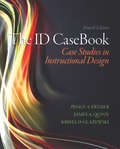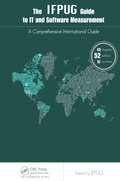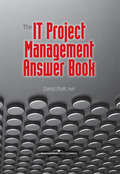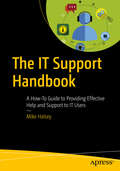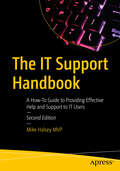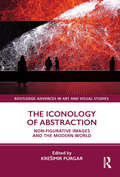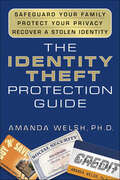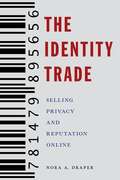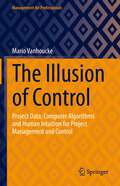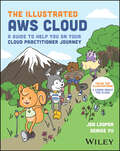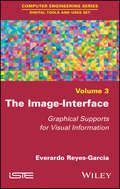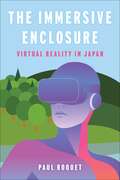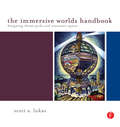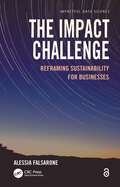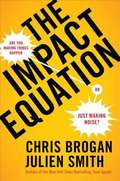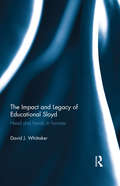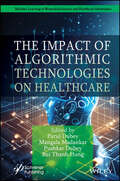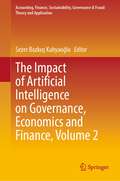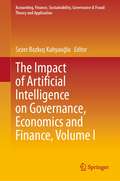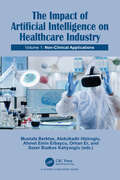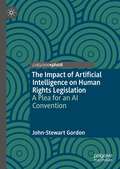- Table View
- List View
The ID CaseBook: Case Studies in Instructional Design
by Peggy A. Ertmer James A. Quinn Krista D. GlazewskiFirst Published in 2017. Routledge is an imprint of Taylor & Francis, an Informa company.The Fourth Edition of this highly regarded problem-solving text presents 30 realistic case studies in a wide range of authentic contexts, from K-12 to post-secondary, corporate, and manufacturing. The cases and their accompanying discussion questions encourage ID students to analyze the available information, develop conclusions, and consider alternative possibilities in resolving ID problems.
The IDA Pro Book: The Unofficial Guide to the World's Most Popular Disassembler (Second Edition)
by Chris Eagle<P>No source code? No problem. With IDA Pro, the interactive disassembler, you live in a source code-optional world. IDA can automatically analyze the millions of opcodes that make up an executable and present you with a disassembly. But at that point, your work is just beginning. With The IDA Pro Book, you'll learn how to turn that mountain of mnemonics into something you can actually use. <P>Hailed by the creator of IDA Pro as "profound, comprehensive, and accurate," the second edition of The IDA Pro Book covers everything from the very first steps to advanced automation techniques. You'll find complete coverage of IDA's new Qt-based user interface, as well as increased coverage of the IDA debugger, the Bochs debugger, and IDA scripting (especially using IDAPython). But because humans are still smarter than computers, you'll even learn how to use IDA's latest interactive and scriptable interfaces to your advantage. <P>Save time and effort as you learn to: <br>–Navigate, comment, and modify disassembly <br>–Identify known library routines, so you can focus your analysis on other areas of the code <br>–Use code graphing to quickly make sense of cross references and function calls <br>–Extend IDA to support new processors and filetypes using the SDK <br>–Explore popular plug-ins that make writing IDA scripts easier, allow collaborative reverse engineering, and much more <br>–Use IDA's built-in debugger to tackle hostile and obfuscated code <P>Whether you're analyzing malware, conducting vulnerability research, or reverse engineering software, a mastery of IDA is crucial to your success. Take your skills to the next level with this 2nd edition of The IDA Pro Book.
The IFPUG Guide to IT and Software Measurement
by IfpugThe widespread deployment of millions of current and emerging software applications has placed software economic studies among the most critical of any form of business analysis. Unfortunately, a lack of an integrated suite of metrics makes software economic analysis extremely difficult.The International Function Point Users Group (IFPUG), a nonpro
The IT Professional's Business and Communications Guide
by Steven JohnsonGet the communication skills you need for career success with this unique book. Preparing you for exams and beyond, the valuable content delves into the issues that you'll face in corporate, retail, and remote support environments. The book offers more than fifty scenarios depicting typical workplace situations, possible responses-and appropriate solutions to guide you. With this approach, you'll gain valuable insight into becoming a team player and learn strategies to communicate more effectively with coworkers and customers.
The IT Project Management Answer Book
by David Pratt PMPZero in on the answers to your IT project management questionsWith constrained schedules and anxious stakeholders eager for results, the typical IT project team doesn't have the luxury of wading through lengthy tomes to find solutions. The IT Project Management Answer Book guides you to the specific answers you need to successfully conduct and complete your IT project.Written in an easy-to-use question-and-answer format, the book covers all aspects of managing an IT project, from initial organizational issues to closeout. Following the classic project management processes, author David Pratt builds on the basics to offer valuable insights not found in other resources, including:• Proven techniques such as the best way to manage defects• How to create performance standards for outside contractors• How to develop a user's manualFor more technically inclined team members, the author's plain-speak approach presents a refreshing view of the IT world. For those less technically oriented, he describes the tools and solutions for dealing with IT project challenges in an accessible, straightforward way. Let this information-packed resource lead you and your team to IT project success.
The IT Support Handbook: A How-To Guide to Providing Effective Help and Support to IT Users
by Mike HalseyBecome a more effective tech professional by learning how to provide the most useful IT support for your users. You'll learn how to efficiently and effectively deal with any type of problem, including operating systems, software, and hardware. IT support is often complex, time-consuming, and expensive, but it doesn't have to be with the right processes in place.Whether you're an individual, part of an IT support team, or managing staff supporting PC users in their homes, The IT Support Handbook will help you understand the right way to approach, troubleshoot, and isolate problems so they can be handled efficiently, with least disruption and cost to your business. You'll make yourself popular with your colleagues, and keep your customers and users happy and productive.What You'll LearnManage reporting, and keep a record of issues that occurProvide effective remote support for users away from home or working in another officeUse error and system reporting in Windows to obtain high-quality, relevant informationSpot patterns in user behavior that may be causing difficult-to-diagnose problemsBe familiar with best practices to make you a better support professionalWho This Book Is ForIT professionals, IT support (on-site and remote), and system administrators who manage support teams. No prior knowledge is required.
The IT Support Handbook: A How-To Guide to Providing Effective Help and Support to IT Users
by Mike HalseyBecome a more effective tech professional by learning how to provide the most useful IT support for your users. You'll learn how to efficiently and effectively deal with any type of problem, including operating systems, software, and hardware. IT support is often complex, time-consuming, and expensive, but it doesn't have to be with the right processes in place. Whether you're an individual, part of an IT support team, or managing staff supporting PC users in their homes, this book will help you understand the right way to approach, troubleshoot, and isolate problems so they can be handled efficiently, with the least disruption and cost to your business. Expanded and revised for this second edition, you'll make yourself popular with your colleagues, and keep your clients and users happy and productive. New To This Edition The world of work has changed, with remote and hybrid working now the new normal and with IT Support departments worldwide having to adapt to this new paradigm. This expanded edition highlights the skills, tools, and structures needed to support businesses of any size in the new normal. What You'll Learn Manage reporting, and keep a record of issues that occur Provide effective remote support for users working from home or elsewhere in the world Use error and system reporting in Windows to obtain high-quality, relevant information Spot patterns in user behavior that may be causing difficult-to-diagnose problems Be familiar with best practices to make you a better support professional Who This Book Is For IT professionals, IT support (on-site and remote), and system administrators who manage support teams. No prior knowledge is required.
The Iconology of Abstraction: Non-figurative Images and the Modern World (Routledge Advances in Art and Visual Studies)
by Krešimir PurgarThis book uncovers how we make meaning of abstraction, both historically and in present times, and examines abstract images as a visual language. The contributors demonstrate that abstraction is not primarily an artistic phenomenon, but rather arises from human beings’ desire to imagine, understand and communicate complex, ineffable concepts in fields ranging from fine art and philosophy to technologies of data visualization, from cartography and medicine to astronomy. The book will be of interest to scholars working in image studies, visual studies, art history, philosophy and aesthetics.
The Identity Theft Protection Guide
by Amanda WelshPROTECTIONPREVENTIONREPAIRIdentity theft is the fastest-growing category of crime in the United States today, and dealing with privacy and identity issues has become an essential part of life in our modern society. Each chapter in The Identity Theft Protection Guide contains a self-quiz to identify personal areas of concern, information to help you "take action," and more. This book shows you how to:* Minimize the risk of identity theft* React if your identity is stolen* Obtain and repair credit and insurance reports, and more* Deal with direct marketers, junk mailers, and telephone solicitors* Stop surveillance from GPS devices and cell-phone cameras* Keep your kids safe online* And much more!These valuable survival skills can no longer be considered optional--they are essential for life in today's society. Amanda Welsh's The Identity Theft Protection Guide is the most complete, authoritative, and easy-to-use resource on this crucial topic.
The Identity Trade: Selling Privacy and Reputation Online (Critical Cultural Communication #7)
by Nora A. DraperThe successes and failures of an industry that claims to protect and promote our online identitiesWhat does privacy mean in the digital era? As technology increasingly blurs the boundary between public and private, questions about who controls our data become harder and harder to answer. Our every web view, click, and online purchase can be sold to anyone to store and use as they wish. At the same time, our online reputation has become an important part of our identity—a form of cultural currency.The Identity Trade examines the relationship between online visibility and privacy, and the politics of identity and self-presentation in the digital age. In doing so, Nora Draper looks at the revealing two-decade history of efforts by the consumer privacy industry to give individuals control over their digital image through the sale of privacy protection and reputation management as a service.Through in-depth interviews with industry experts, as well as analysis of media coverage, promotional materials, and government policies, Draper examines how companies have turned the protection and promotion of digital information into a business. Along the way, she also provides insight into how these companies have responded to and shaped the ways we think about image and reputation in the digital age.Tracking the successes and failures of companies claiming to control our digital ephemera, Draper takes us inside an industry that has commodified strategies of information control. This book is a discerning overview of the debate around who controls our data, who buys and sells it, and the consequences of treating privacy as a consumer good.
The Illusion of Control: Project Data, Computer Algorithms and Human Intuition for Project Management and Control (Management for Professionals)
by Mario VanhouckeThis book comprehensively assesses the growing importance of project data for project scheduling, risk analysis and control. It discusses the relevance of project data for both researchers and professionals, and illustrates why the collection, processing and use of such data is not as straightforward as most people think. The theme of this book is known in the literature as data-driven project management and includes the discussion of using computer algorithms, human intuition, and project data for managing projects under risk. The book reviews the basic components of data-driven project management by summarizing the current state-of-the-art methodologies, including the latest computer and machine learning algorithms and statistical methodologies, for project risk and control. It highlights the importance of artificial project data for academics, and describes the specific requirements such data must meet. In turn, the book discusses a wide variety of statistical methods available to generate these artificial data and shows how they have helped researchers to develop algorithms and tools to improve decision-making in project management. Moreover, it examines the relevance of project data from a professional standpoint and describes how professionals should collect empirical project data for better decision-making. Finally, the book introduces a new approach to data collection, generation, and analysis for creating project databases, making it relevant for academic researchers and professional project managers alike.
The Illustrated AWS Cloud: A Guide to Help You on Your Cloud Practitioner Journey
by Jen Looper Denise YuAn intuitive, fully illustrated guide to Amazon Web Services for the visually oriented In The Illustrated AWS Cloud: A Guide to Help You On Your Cloud Practitioner Journey, a team of veteran tech educators delivers a visual and entertaining guide to Amazon Web Services cloud concepts. The authors focus on the job role and responsibilities of an AWS cloud practitioner, guiding readers through choosing the best AWS services for specific use cases. In addition to general cloud concepts, security and compliance, technology, and billing and pricing topics, you’ll find: High-resolution, black-and-white illustrations clearly explaining critical technical concepts Comprehensive coverage of working with an AWS account and understanding the AWS environment Complete chapters on each of the main categories of AWS services, including Compute, Storage, Database, and NetworkingThe authors also provide bonus content on their companion website at https://illustratedaws.cloud/. Perfect for anyone looking for an easy-to-follow and visual introduction to the Amazon Web Services cloud, including those considering a career as a cloud administrator or technical support person, The Illustrated AWS Cloud is an effective resource for business, finance, sales, and marketing professionals who support and collaborate with AWS tech professionals.
The Image-Interface: Graphical Supports for Visual Information
by Everardo Reyes-GarciaDigital practices are shaped by graphical representations that appear on the computer screen, which is the principal surface for designing, visualizing, and interacting with digital information. Before any digital image or graphical interface is rendered on the screen there is a series of layers that affect its visual properties. To discover such processes it is necessary to investigate software applications, graphical user interfaces, programming languages and code, algorithms, data structures, and data types in their relationship with graphical outcomes and design possibilities. This book studies interfaces as images and images as interfaces. It offers a comprehensible framework to study graphical representations of visual information. It explores the relationship between visual information and its graphical supports, taking into account contributions from fields of visual computing. Graphical supports are considered as material but also as formal aspects underlying the representation of digital images on the digital screen.
The Immersive Enclosure: Virtual Reality in Japan
by Paul RoquetAlthough virtual reality promises to immerse a person in another world, its true power lies in its ability to sever a person’s spatial situatedness in this one. This is especially clear in Japan, where the VR headset has been embraced as a way to block off existing social environments and reroute perception into more malleable virtual platforms. Is immersion just another name for enclosure?In this groundbreaking analysis of virtual reality, Paul Roquet uncovers how the technology is reshaping the politics of labor, gender, home, and nation. He examines how VR in Japan diverged from American militarism and techno-utopian visions and became a tool for renegotiating personal space. Individuals turned to the VR headset to immerse themselves in three-dimensional worlds drawn from manga, video games, and genre literature. The Japanese government promised VR-operated robots would enable a new era of remote work, targeting those who could not otherwise leave home. Middle-aged men and corporate brands used VR to reimagine themselves through the virtual bodies of anime-styled teenage girls. At a time when digital platforms continue to encroach on everyday life, The Immersive Enclosure takes a critical look at these attempts to jettison existing social realities and offers a bold new approach for understanding the media environments to come.
The Immersive Internet
by Robin Teigland Dominic PowerCollecting short thought pieces by some of the leading thinkers on the emerging 'Immersive Internet', Power and Teigland's book questions what a more immersive and intimate internet - based on social media, augmented reality, virtual worlds, online games, 3D internet and beyond - might mean for society and for each of us.
The Immersive Worlds Handbook: Designing Theme Parks and Consumer Spaces
by Scott LukasScott Lukas, famed industry expert on designing themed spaces, brings you a book that focuses on the imaginative world of themed, immersive and consumer spaces. Whether or not you are involved in designing a theme park, cultural museum, shop, or other entertainment space, you will benefit from the insider tips, experiences, and techniques highlighted in this practical guide. Make your themed spaces come to life and become true, immersive worlds. The book features informative sidebars addressing possible design issues and current trends; case studies and interviews with real-world designers, and further reading suggestions. The book also includes a companion website, as well as exercises that accompany each chapter, lavish photos, illustrations, and tables.
The Impact Challenge: Reframing Sustainability for Businesses (Impactful Data Science)
by Alessia FalsaroneThis book explores the role of businesses in delivering positive societal and financial outcomes as they seek to bridge the gap between short-term organizational behaviors and long-range sustainability commitments. By addressing the inevitable data challenges associated with the strategic integration of a sustainability mindset, it enables faster adoption of social, environmental and governance metrics that generate lasting enterprise value. Inspired by the experience of practitioners that have successfully influenced the learning behaviors of complex organizations, this book helps readers drive systemic innovations as they leverage sustainability initiatives in a programmatic and intentional manner. Features: Defines a toolkit to generate sustainable business value by focusing on the organizational design underpinning sustainability-oriented initiatives. Provides a multidisciplinary lens on shaping the impact dialogue through applied frameworks. Discusses the need to analytically identify an organizational learning curve before developing impact targets and framing sustainability commitments around them. Combines theory and practice in a practical style by presenting a variety of real-life applications at a global level.
The Impact Equation: Are You Making Things Happen or Just Making Noise?
by Chris Brogan Julien SmithChris Brogan and Julien Smith, authors of Trust Agents, are back with The Impact Equation to show you how to make social media pay. What can the IMPACT EQUATION do for you? IMPACT = C × (R+E+A+T+E) Contrast: Does your idea stand out? Reach: How many people do you connect to? Exposure: How often does your audience hear from you? Articulation: Is your idea clear enough? Trust: Do people believe you? Echo: Does your idea connect to your audience? When Chris Brogan and Julien Smith wrote their bestseller Trust Agents, being interesting on the Web was enough to build an audience. Now everybody has a platform. But most of them are just making noise. In The Impact Equation, Brogan and Smith show that to make people truly care about what you have to say, you need more than just a good idea, trust among your audience, or a certain number of followers. You need a potent mix of all of the above - and more. As traditional channels for marketing and selling disappear and more people interact mainly online, the very nature of attention is changing. Use the Impact Equation to figure out what you're doing right and wrong. Apply it to a blog, a tweet, a video, or a mainstream advertising campaign. Use it to explain why a feature in a national newspaper that reaches millions might have less impact than a blog post that reaches a thousand passionate subscribers. The Impact Equation will give you the tools to guarantee your message will be heard. 'Their advice on the importance of being able to write to make a splash online is solid. . . when it comes to building a brand online Brogan and Smith have been there and done that' -The Financial TimesChris Brogan and Julien Smith are consultants and speakers who have worked with Fortune 500 companies, including PepsiCo, General Motors, American Express, and Microsoft. They have been involved in online communities and blogging for more than fifteen years. Their first book, Trust Agents, was a New York Times bestseller.
The Impact and Legacy of Educational Sloyd: Head and hands in harness
by David J. WhittakerOriginating in Finland in eighteen-sixty-five, Educational Sloyd used handicrafts practised in schools to promote educational completeness through the interdependence of the mind and body. These radical ideas spread throughout Europe and America and had a significant impact on the early development of manual training, manual arts, industrial education and technical education. Today it is generally acknowledged that Educational Sloyd laid the foundations of modern technological education. This book traces the development of Sloyd from its conception by Uno Cygnaeus and the first Sloyd school founded by Otto Salomon, to its enthusiastic take up in Scandinavia and beyond. It examines the debates and controversy which surround the Sloyd system, and considers the transition from ‘hands-on’ craft work to concepts of technology education. Finally, the investigation reveals the lasting legacy of the ideas and practice of Sloyd education, and how it continues to influence technological education. Included in the book: - the foundations of Educational Sloyd - debates, controversy and rival factions - key case studies in Finland and Iceland - the lasting legacy of Sloyd education. This fascinating and comprehensive historical exploration will be of interest to scholars and researchers in the areas of technology education, comparative education and the history of education.
The Impact of Algorithmic Technologies on Healthcare (Machine Learning in Biomedical Science and Healthcare Informatics)
by Bui Thanh Hung Parul Dubey Mangala Madankar Pushkar DubeyThe book explores the fundamental principles and transformative advancements in cutting-edge algorithmic technologies, detailing their application and impact on revolutionizing healthcare. This book provides an in-depth account of how technologies such as artificial intelligence (AI), machine learning (ML), and the Internet of Things (IoT) are reshaping healthcare, transitioning from traditional diagnostic and treatment approaches to data-driven solutions that improve predictive accuracy and patient outcomes. The text also addresses the challenges and considerations associated with adopting these technologies, including ethical implications, data security concerns, and the need for human-centered approaches in algorithmic medicine. After introducing digital twin technology and its potential to enhance healthcare delivery, the book examines the broader effects of digital technology on the healthcare system. Subsequent chapters explore topics such as innovations in medical imaging, predictive analytics for improved patient outcomes, and deep learning algorithms for brain tumor detection. Other topics include generative adversarial networks (GANs), convolutional neural networks (CNNs), smart wearables for remote patient monitoring, effective IoT solutions, telemedicine advancements, and blockchain security for healthcare systems. The integration of biometric systems driven by AI, securing cyber-physical systems in healthcare, and digitizing wellness through electronic health records (EHRs) and electronic medical records (EMRs) are also discussed. The book concludes with an extensive case study comparing the impacts of various healthcare applications, offering insights and encouraging further research and innovation in this dynamic field. Audience This book is suitable for academicians and professionals in health informatics, bioinformatics, biomedical science and engineering, artificial intelligence, as well as clinicians, IT specialists, and policymakers in healthcare.
The Impact of Artificial Intelligence in Radiology (AI in Clinical Practice)
by Adam E. M. Eltorai, Ian Pan, and H. Henry GuoImplementation of artificial intelligence (AI) in radiology is an important topic of discussion. Advances in AI—which encompass machine learning, artificial neural networks, and deep learning—are increasingly being applied to diagnostic imaging. While some posit radiologists are irreplaceable, certain AI proponents have proposed to "stop training radiologists now." By compiling perspectives from experts from various backgrounds, this book explores the current state of AI efforts in radiology along with the clinical, financial, technological, and societal perspectives on the role and expected impact of AI in radiology.
The Impact of Artificial Intelligence on Governance, Economics and Finance, Volume 2 (Accounting, Finance, Sustainability, Governance & Fraud: Theory and Application)
by Sezer Bozkuş KahyaoğluThis book continues the discussion of the effects of artificial intelligence in terms of economics and finance. In particular, the book focuses on the effects of the change in the structure of financial markets, institutions and central banks, along with digitalization analyzed based on fintech ecosystems. In addition to finance sectors, other sectors, such as health, logistics, and industry 4.0, all of which are undergoing an artificial intelligence induced rapid transformation, are addressed in this book.Readers will receive an understanding of an integrated approach towards the use of artificial intelligence across various industries and disciplines with a vision to address the strategic issues and priorities in the dynamic business environment in order to facilitate decision-making processes. Economists, board members of central banks, bankers, financial analysts, regulatory authorities, accounting and finance professionals, chief executive officers, chief audit officers and chief financial officers, chief financial officers, as well as business and management academic researchers, will benefit from reading this book.
The Impact of Artificial Intelligence on Governance, Economics and Finance, Volume I (Accounting, Finance, Sustainability, Governance & Fraud: Theory and Application)
by Sezer Bozkuş KahyaoğluThe book discusses the effects of artificial intelligence in terms of economics and finance. In particular, the book focuses on the effects of the change in the structure of financial markets, institutions and central banks, along with digitalization analyzed based on fintech ecosystems. In addition to finance sectors, other sectors, such as health, logistics, and industry 4.0, all of which are undergoing an artificial intelligence induced rapid transformation, are addressed in this book.Readers will receive an understanding of an integrated approach towards the use of artificial intelligence across various industries and disciplines with a vision to address the strategic issues and priorities in the dynamic business environment in order to facilitate decision-making processes. Economists, board members of central banks, bankers, financial analysts, regulatory authorities, accounting and finance professionals, chief executive officers, chief audit officers and chief financial officers, chief financial officers, as well as business and management academic researchers, will benefit from reading this book.
The Impact of Artificial Intelligence on Healthcare Industry: Volume 1: Non-Clinical Applications
by Sezer Bozkus Kahyaoglu Mustafa Berktas Abdulkadir Hiziroglu Ahmet Emin Erbaycu Orhan ErHealthcare and medical science are inherently dependent on technological advances and innovations for improved care. In recent times we have witnessed a new drive in implementing these advances and innovations through the use of Artificial Intelligence, in both clinical and non-clinical areas.The set of 2 volumes aims to make available the latest research and applications to all, and to present the current state of clinical and non-clinical applications in the health sector and areas open to development, as well as to provide recommendations to policymakers. This volume covers non-clinical applications. The chapters covered in this book have been written by professionals who are experts in the healthcare sector and have academic experience.
The Impact of Artificial Intelligence on Human Rights Legislation: A Plea for an AI Convention
by John-Stewart GordonThe unmatched technological achievements in artificial intelligence (AI), robotics, computer science, and related fields over the last few decades can be considered a success story. The technological sophistication has been so groundbreaking in various types of applications that many experts believe that we will see, at some point or another, the emergence of general AI (AGI) and, eventually, superintelligence. This book examines the impact of AI on human rights by focusing on potential risks and human rights legislation and proposes creating a Universal Convention for the Rights of AI Systems (AI Convention).
